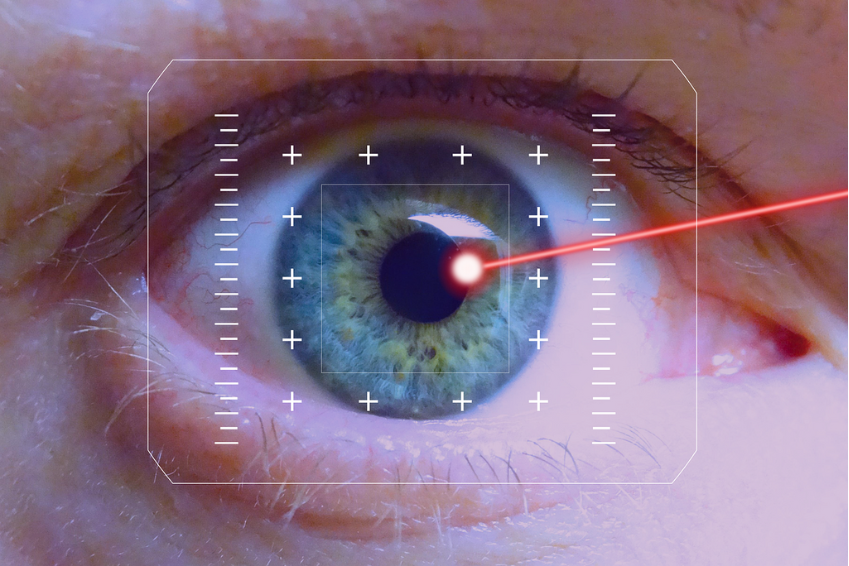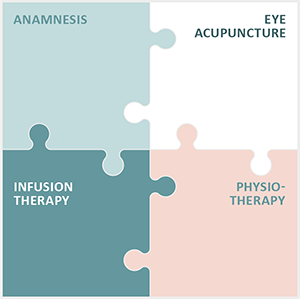The different options for Diabetic Retinopathy treatment

Diabetic Retinopathy Treatment: A comprehensive approach to slow down the disease. Laser treatment as one option.
Diabetic Retinopathy treatment in conventional medicine is much debated. There is no possibility of achieving a complete cure for Diabetic Retinopathy. In some cases, however, a certain halt to the progression of the disease can be achieved.
Various steps are recommended to support the therapeutic measures and prevent the progression of retinopathy. These include weight reduction in patients who are overweight, maintaining sufficient physical activity, changing dietary habits and abstaining from alcohol.
Continuous monitoring and adjustment of blood glucose levels also plays a particularly important role in ensuring stability and thus curbing the progression of Diabetic Retinopathy.
For a more detailed overview of the available treatment options, we recommend the following summary of all treatment options.
Diabetic Retinopathy Treatment: Laser treatment as one option
In some cases, laser therapy can be considered after the first signs of eye damage appear. Laser beams are targeted at the damaged retina in order to destroy pathological vascular growths and prevent the development of new vascular changes.
This approach can be particularly promising in the early stages of the disease. However, it should be noted that if the eyes are already significantly vascularised, laser therapy may no longer be sufficiently effective.
Nevertheless, the fact that early intervention can improve the chances of success emphasises the importance of regular eye examinations and a rapid response to possible signs of Diabetic Retinopathy.
Here are the different options for Diabetic Retinopathy treatment using lasers:
- Panretinal photocoagulation (PRP): laser beams seal peripheral abnormal blood vessels and improve retinal oxygenation.
- Focal laser therapy: Targeted laser beam treats individual abnormal blood vessels, reduces haemorrhage and swelling.
- Decompression laser: Reduces vitreous haemorrhage and improves vision.
- Laser-induced regression therapy (LRT): Reduces blood flow in abnormal vessels and promotes regression.
- Intravitreal anti-VEGF injections: Inhibit the growth of new blood vessels through drug injections.
- Laser photocavities: Reduce fluid accumulation in macular oedema to improve central visual acuity.
The choice of laser treatment depends on the stage and type of Diabetic Retinopathy and requires consultation with an ophthalmologist.
Surgery one of the last options for treating Diabetic Retinopathy
In advanced stages of Diabetic Retinopathy, surgical procedures may be considered to treat the progressive damage to the eye and preserve or improve vision.
These procedures are often performed by a specialised retinal surgeon and may include the following:
- Vitrectomy: The surgeon removes the cloudy vitreous gel from the eye, improving retinal vision to treat haemorrhage and scarring.
- Photocoagulation: The surgeon may use laser beams to treat abnormal blood vessels and stop bleeding to reduce potential damage.
- Removal of vitreous haemorrhages: If there is bleeding in the vitreous gel, the surgeon can remove it to improve the patient’s vision.
- Retinal repositioning: In advanced cases where the retina has become detached from its normal position (retinal detachment), surgery may be necessary to reattach the retina.
It is important to emphasise that surgery is usually considered in advanced stages of Diabetic Retinopathy when other treatments may no longer be sufficient.
Naturopathic treatment of Diabetic Retinopathy Treatment
Naturopathic treatment options include, for example
- Eye acupuncture
- Physiotherapy
- Vital substance therapy / infusion therapy
- Change of diet
Early intervention is crucial to maximise the chances of success.
In the early stages of the disease, characterised by the first signs of retinal haemorrhage, ocular acupuncture can achieve positive results.
However, it should be noted that the response to this treatment in diabetics must be awaited patiently due to the slow reaction time of the organism. The haemorrhages may subside in the course of the therapy, but this does not happen immediately.
Targeted physiotherapy can stimulate the pancreas, which in turn influences the entire metabolism. In diabetics, it is particularly important to stimulate and closely monitor all metabolic processes.
Metabolism-stimulating therapeutic approaches are generally suitable, but require precise control of blood sugar levels.
An adequate supply of vital substances is crucial for optimal eye function. Due to the potentially increased need for vital substances as a result of conventional medical medication, regular laboratory tests should be carried out to identify and compensate for any deficiencies.
Dietary changes should always be made in conjunction with expert nutritional counselling to ensure the best possible success.
A summary of the various options for Diabetic Retinopathy treatment
The treatment of Diabetic Retinopathy requires a comprehensive approach that combines conventional medical approaches and naturopathic therapy options. There is no complete cure for this disease, but halting the progression of the disease is possible in some cases.
To slow the progression of retinopathy, steps such as weight management, physical activity, dietary changes, alcohol avoidance and, above all, careful control of blood glucose levels are crucial.
Laser therapy offers a promising option, especially in the early stages of the disease. Various laser treatments, including panretinal photocoagulation, focal laser therapy and laser-induced regression therapy, can be used, depending on the stage and type of disease.
Surgical interventions such as vitrectomy or photocoagulation are considered in advanced stages when other measures are no longer sufficient.
Naturopathic approaches such as eye acupuncture, physiotherapy, vital substance therapy and dietary changes can also provide support.
Early intervention and holistic care are crucial to maximise the chances of success in the treatment of Diabetic Retinopathy.
Therapeutic approaches for diabetic retinopathy – Augenakupunktur Noll
Diabetic retinopathy is a challenging complication of diabetes, the treatment of which requires a multi-faceted approach. In addition to traditional methods such as laser therapy and surgical interventions, Noll eye acupuncture expands the spectrum with a holistic treatment approach.
The Integrated Eye Therapy according to Noll, specially developed by Michaela Noll, combines proven traditional methods with innovative techniques to treat patients with chronic and degenerative eye diseases on an individualised basis. Our method is based on:
- an in-depth anamnesis,
- includes targeted eye acupuncture according to Prof Boel,
- customised infusions
- and specially tailored physiotherapy
And thus offers an option to support diabetic retinopathy treatment. In over a decade, we have built up an international patient base and are grateful for the numerous positive feedback.

